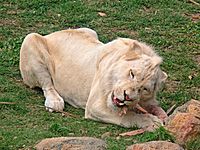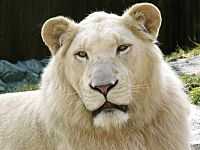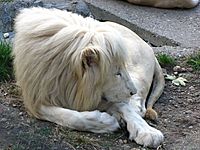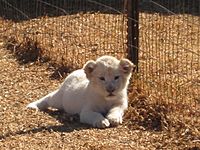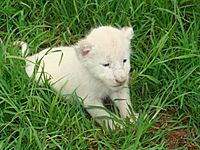White lion facts for kids
The white lion is a very rare color change in the lion. It's a special kind of Southern African lion. White lions from the Timbavati area in South Africa have lived there for hundreds of years. People first officially saw them in this area in 1938. The world learned about white lions in 1977 from a book called The White Lions of Timbavati.
Contents
About White Lions
White lions are not albinos. Albinos have no color at all. White lions have a condition called leucism. This means they have less color pigment in their fur, but they still have color in their eyes, paw pads, and lips. Their color can be light blonde to almost white. This special color does not seem to make it harder for them to survive in the wild.
White lions were thought to be gone from the wild between 1992 and 2004. But then, the Global White Lion Protection Trust successfully brought them back. These lions have continued to hunt and have cubs in the wild. Other white lion births have also been seen in the larger Kruger area since then.
Breeding and Life Cycle
When lions that are too closely related breed (this is called inbreeding), it can cause serious health problems for their cubs. For example, it can lead to issues with their brain or spinal cord. However, groups like The Global White Lion Protection Trust work to release white lions born in zoos back into their natural homes in a safe and ethical way.
White Lions in Zoos and Parks
Many zoos and wildlife parks around the world have white lions. Here are a few examples:
- The Inkwenkwezi Private Game Reserve in South Africa has a program to breed white lions.
- In the 1990s, four white lion cubs were born at the Papanack Park Zoo near Ottawa, Canada.
- In 2017, some white lions were found being moved illegally from Afghanistan. They were later taken to the Kabul Zoo and another zoo in Kandahar Province.
Lory Park Zoo
Lory Park Zoo has two adult white lions, Daniel and Heidi. They have had eight cubs. In 2012, three cubs were born and raised by humans. In 2013, five more cubs were born. Two of these cubs, Gabriel and Gazelle, stayed with their parents and were not handled by humans.
Kruger and Umfolozi
In 1979, white lion cubs were seen in Kruger National Park. A female lion with three white cubs was spotted. Later, three more white cubs from two different mothers were seen. A white lion was also observed in the Hluhluwe-Umfolozi Game Reserve in Zululand.
Rustenburg Wildlife Rehabilitation Center
In 2018, a three-year-old white lion named Mufasa was being sold in South Africa. He had been kept illegally as a pet. Many people signed a petition asking that Mufasa not be sold at an auction. They worried he might be bought for hunting. An anonymous buyer wanted to protect Mufasa and another female lion named Soraya.
White Lions in Europe and Asia
The European Association of Zoos and Aquaria does not support purposely breeding white lions.
West Midland Safari Park
In 2004, four white lions came to West Midland Safari Park in the United Kingdom. They were the only white lions in the country at the time.
In 2008, four white lion cubs were born at the park. Later, there were reports that these cubs were sold to perform in a Japanese circus. The park stated they would not have sold the cubs if they knew they would end up in a circus.
Jurques Zoo
In May 2007, four white lion cubs were born at Jurques Zoo in France. The cubs were healthy but needed to be hand-fed because their mother was not taking care of them.
Belgrade Zoo
Belgrade Zoo in Serbia has 12 white lions. Many cubs have been born there, including four in 2010 and four more in 2011.
Tbilisi Zoo
In December 2013, four white lion cubs were born at Tbilisi Zoo in Georgia. These cubs also needed to be hand-fed. Three more cubs were born in May 2014.
Karachi Zoo
In 2012, the Karachi Zoo in Pakistan bought a young male and female white lion. They have since had two cubs.
Bukit Gambang Safari Park, Malaysia
The first white lions in Malaysia arrived in March 2013 at the Safari Park in Bukit Gambang Resort City. The first white lion cub born there was named King in May 2014.
Wildlife Park of Sunway Lagoon, Malaysia
A pair of white lions named Zola and Zuri live at Sunway Lagoon's Wildlife Park.
Taman Safari Indonesia
Taman Safari in Indonesia got six white lions from Canada in 2018.
White Lions in the Americas
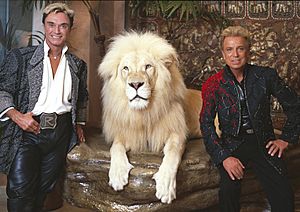
Toronto Zoo
In 2012, Toronto Zoo in Canada welcomed three white lions. In September 2015, four white lion cubs were born at the zoo.
Cincinnati Zoo
In 1998, Cincinnati Zoo in Ohio received two white lions. One of them, Prosperity, lived to be 22 years old.
Reino Animal
The Mexican zoo Reino Animal has a pair of white lions that visitors can see on their "Lions' Safari."
The Wild Animal Sanctuary
The Wild Animal Sanctuary in Keenesburg, Colorado, has rescued white lions from various places. These lions live out their lives in large outdoor areas, safe from being used for profit.
White Lions in Oceania
Kingdom of Zion
Kingdom of Zion, a private zoo in New Zealand, has six male and four female white lions.
Genetics of White Lions
Genetically, the white lion is the same type of lion as the normal-colored (tawny) South African lion. These lions live in some wildlife reserves in South Africa and in zoological parks worldwide.
White lions are not albinos. They are leucistic. This means they have some pigment (color) in their eyes, paw pads, and lips. Their eyes can be hazel, golden, blue-gray, or green-gray.
The white color comes from a special change (a recessive mutation) in a gene. This gene is responsible for making melanin, which is the substance that gives color to skin, hair, and eyes. This change means less color is put into the hair, making the lions look paler. That's why "white" lions can be blonde to almost completely white. Male white lions have pale manes and tail tips instead of the usual dark ones.
In 2013, scientists found the exact genetic marker that causes the white color. This was after a 7-year study led by the Global White Lion Protection Trust.
White Lions in Their Natural Home
From the 1970s, white lions were taken from the wild because they were rare. Many normal-colored lions carrying the white gene were also removed. They were put into breeding programs, sent to zoos, or used in circuses. After 1992, no adult white lions were seen in their natural habitat.
So, in 2004, the Global White Lion Protection Trust (WLT) started a project to bring white lions back to their natural home. They used special methods to reintroduce them. The cubs born in the wild from these reintroduced white lions joined groups of normal-colored lions.
Now, three groups of white lions, mixed with tawny lions, are living and hunting successfully in their natural home. They hunt just as well as other wild lions. The genetic marker found in 2013 helps make sure these lions are genetically healthy.
The main goal of the Global White Lion Protection Trust is to use the importance of white lions to local people to help protect the larger lion population in the Kruger to Canyon area. This is similar to how the Kermode Bear in Canada is protected. By protecting the rare white Kermode Bear, a huge wilderness area is also protected. In the same way, protecting white lions helps protect all lions in their home area.
White lion cubs have been born in the Timbavati Private Nature Reserve in recent years (2006, 2008, 2009, 2011, 2012, 2013). They have also been born in Kruger National Park in 2014 and 2015. This shows that white lions are a natural part of the wild population, and the special gene is still present.
See also
 In Spanish: León blanco para niños
In Spanish: León blanco para niños
- White tiger
- Black panther
- Drakenstein Lion Park
- Kimba the White Lion
- King Cheetah
- Melanistic Asiatic lion
- Siegfried & Roy
- White panther
- Kermode bear
- Cinnamon bear
- White stag


